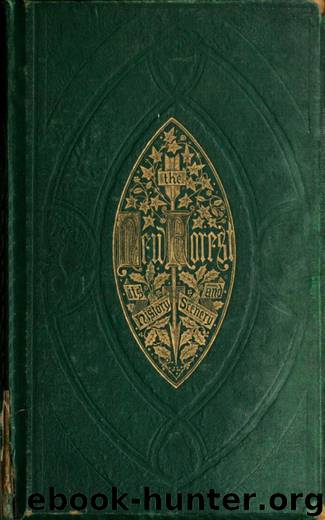The New Forest, Its History and its Scenery by John R. Wise

Author:John R. Wise [Wise, John R.]
Language: eng
Format: epub
Publisher: anboco
Published: 2017-02-08T23:00:00+00:00
Common Buzzard’s Nest.
Honey-Buzzard’s Nest.
The accompanying vignette will, I trust, although the nests are so exactly alike, be of some interest. Whilst the artist was sketching the honey-buzzard’s nest, the old bird, the first which I had noticed in 1862, made its appearance and circled round the tree, uttering its peculiar short shrill squeak. This nest, which had been repaired in the previous year, the dead beech-leaves still hanging on to the twigs, was between forty and fifty feet from the ground; whilst that of the common buzzard, who, whilst sitting, had, a month before, been killed, was upwards of seventy feet, and placed on the very topmost boughs of a beech, on which tree was also the other.
But more important than even the nesting of the honey-buzzard is that of the merlin ( Falco æsalon ), which fact has never yet been, so far as I know, noticed as occurring in the New Forest. In the winter this little hawk is sometimes seen hunting, as it does in Ireland, the snipe, although but few specimens find their way to the bird-stuffer. It lingers on, however, to the summer, but the opportunities then of watching its habits are more rare, as the foliage of the woods is so thick. In 1859 and 1861 Mr. Farren received two nests with three eggs, taken in old pollard hollies growing in the open heath, which in every way corresponded with those of the merlin, being considerably smaller than those of kestrels. Unfortunately, however, he could not procure the parent birds, and the fact of the merlin’s nesting remained doubtful. In 1862 he was at last successful, and on May 22nd discovered a nest, placed in the hole of a yew, also containing, like the others, three eggs, from which the male bird was shot. Both the bird and eggs are now in my collection, the latter being somewhat richer and darker in colour than those which I have received from the Orkney and Shetland islands. The important fact, however, to be noticed is that, as Temminck remarks, the birds in a woody country build in trees, whilst in the north of Britain, where there is no timber, they adapt themselves to the country, and lay on the ground. [286]
Download
This site does not store any files on its server. We only index and link to content provided by other sites. Please contact the content providers to delete copyright contents if any and email us, we'll remove relevant links or contents immediately.
| Africa | Americas |
| Arctic & Antarctica | Asia |
| Australia & Oceania | Europe |
| Middle East | Russia |
| United States | World |
| Ancient Civilizations | Military |
| Historical Study & Educational Resources |
Room 212 by Kate Stewart(5070)
The Crown by Robert Lacey(4761)
Endurance: Shackleton's Incredible Voyage by Alfred Lansing(4719)
The Iron Duke by The Iron Duke(4319)
The Rape of Nanking by Iris Chang(4165)
Joan of Arc by Mary Gordon(4053)
Killing England by Bill O'Reilly(3968)
Say Nothing by Patrick Radden Keefe(3937)
I'll Give You the Sun by Jandy Nelson(3394)
Shadow of Night by Deborah Harkness(3324)
Hitler's Monsters by Eric Kurlander(3291)
Mary, Queen of Scots, and the Murder of Lord Darnley by Alison Weir(3171)
Blood and Sand by Alex Von Tunzelmann(3164)
Eleanor & Park by Rainbow Rowell(3110)
Darkest Hour by Anthony McCarten(3096)
Margaret Thatcher: The Autobiography by Thatcher Margaret(3046)
Book of Life by Deborah Harkness(2892)
Red Famine: Stalin's War on Ukraine by Anne Applebaum(2890)
The One Memory of Flora Banks by Emily Barr(2829)
